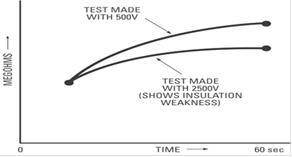Megohmmeters, or Insulation Resistance (IR) Testers, are used to measure the resistance, integrity and safety of electrical wiring insulation. As electrical insulation breaks down, there are many hazards that can occur. Electrical shock and injury to personnel, system failure as well as machinery failure, fire hazard and certainly operation downtime become major problems.
Insulation Testing is recommended to be included as part of a normal annual or semi-annual maintenance program. If a program is initiated and insulation deterioration and wiring hazards are found, maintenance and repair times can be scheduled. Insulation failure and deterioration is caused by many factors. Some of those include excessive heat or cold, mechanical damage, moisture, dirt, corrosive vapors, vibration, aging, and cut or broken wiring.
Typical Applications for Megohmmeters
- Wiring and Cable
- Transformers
- Motors
- Generators
- Switchgear
- Capacitors
- Rotating Machinery
- Insulators
- Acceptance Testing for Conformance
- Preventive Site Maintenance
- QA in Manufacturing
- Diagnostic Testing
- Multi-Layer Insulation (DD)
3 Primary Insulation Test Methods
There are a variety of accepted test methods for insulation testing. There are primarily three different tests performed when considering Insulation Resistance. These are used for motors, transformers, and generators, but may also be used for wire and cable. Please note that all insulation tests should only be performed on de-energized circuits.
1. Spot Reading Test
A Spot Reading test is a single insulation test taken at a fixed voltage over the same time interval and usually done on a regular maintenance program schedule. The time interval for each test is usually no less than 60 seconds. Many spot tests are done annually, but may be done more frequently. All tests must be done with the identical existing conditions, so that temperature and humidity should be as close to the previous test. The timing of these tests is based on individual requirements, but should always be at the identical voltages at approximately the same time of year. These results are plotted to show the “history” of each test product over time. Please see Figure 1 below that indicates a 6 year tabulation of “Spot Reading Tests” where product failure and deterioration is shown over a period of years. Note the correction of the insulation problem indicated in the tabulation.
2. Time Resistance Test
This test applies a selected voltage over two periods of time. The first period is usually at 10 minutes and the second period is at 1 minute. If the equipment insulation is good, the insulation resistance increases over time. If the insulation is damaged or the integrity of the insulation contains moisture, oil or other contaminants, the resistance values will remain level or decrease. Please note figure 2 below which demonstrates that product D is acceptable and product E may be questionable. When proceeding with the Time Test, it is important to note the following:
Dielectric Absorption (DAR) = 1 minute test resistance / 30 second test resistance
Dielectric Absorption, DAR- (also referred to “absorption ratio”), is an indication of good insulation. DAR values that have been used as empirical references, especially for motors and windings are:
If the DAR value is less than 1.0, the unit under test has probably failed.
If the DAR value is between 1.0 and 1.25, the unit is questionable.
If the DAR value is between 1.4 and 1.6, the unit is good.
If the DAR value is above 1.6, the unit is excellent.
3. Step Voltage
This test incorporates applying two or more test voltages over a fixed interval of time. The increase in Voltage applies an increased stress level on possible insulation leakage paths. This procedure may find problems in insulation that otherwise products may have tested OK with either the Spot or Time Tests. Please note that figure three below demonstrates that a test at 500V has different results from a 2500V test. Many technicians choose 5 different voltages, but each test must be at the identical time interval. The intervals are usually set at 1 minute and range each minute from 1 minute to 10 minutes. Please note that figure 2 above shows a 10 minute test that indicates that product D is fine but Product E is questionable and may contain damage. When applying the Step Voltage Test, a standard interpretation of the results is called the
Polarization Index and is represented by:
Polarization Index (PI) = 10 minute test resistance / 1 minute test resistance
The Polarization Index is the ratio of the 10-minute insulation resistance test to the 1-minute insulation resistance test. The results will indicate whether any insulation deterioration is occurring. This is a good test especially for motor windings. The IEEE Standard for minimum values for rotating machinery based on class is:
- Class A = 1.5
- Class B = 2.0
- Class C = 2.0
 Figure 3
Figure 3The general accepted value for test voltages (DC Voltages on Most Newer Megohmmeters) is twice the nameplate voltage for the equipment or cable. A cable or piece of equipment with a 50V rating would be tested at no less than 100V. A transformer or motor winding rated at 480V would be tested at 1000V. If AC voltage is applied, the general accepted value would be twice the nameplate voltage + 1000V. If a nameplate does not have any specified voltage rating, please contact the original equipment manufacturer for the rated maximum voltage specifications.
The table above shows the recommended test voltagees according to the operating voltages of installations and equipment (taken from the IEEE 43-2000 Guide).